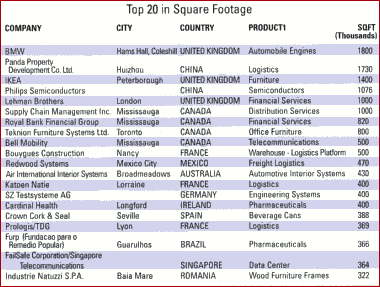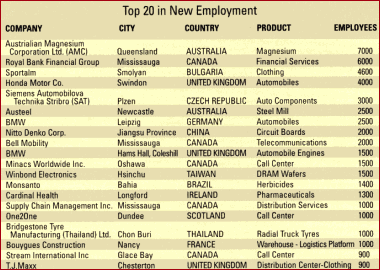anada, China and Australia remained the preferred international locations for doing business in 2001, according to a survey of global location activity chronicled in
Site Selection magazine’s New Plants Database.
Just like they did in 2000, Canada and the Asia-Pacific region of the Far East once again dominated the annual ranking of largest international (non-U.S.) facility investments in 2001.
Of the top 20 global facilities for 2001 in terms of capital investment, the Far East led the way with seven of the top 10. Taiwan flexed its economic muscle by recording — for the first time ever — the three largest capital investments of the year: a US$6 billion steel mill by the China Steel Corp., a $6 billion wafer fabrication plant by Macronix and a $3.5 billion wafer fab by Winbond Electronics.
Australia was the other big player in this category, registering four of the 20 largest capital investments: a $1.6 billion aluminum smelting plant for Aldoga Aluminum, a $1.5 billion steel mill for Austeel, a $1.4 billion aluminum refinery for Comalco and a $1.3 billion magnesium plant for Australian Magnesium Corp.
Other multiple-entry counties in the top 20 in this category included China with two projects, Kuwait with two and Japan with two. The top industries represented among the largest investments were wafer/semiconductor chip plants (eight projects), chemical plants (six) and aluminum or steel factories (four).
Canada, Europe Dominate Race for Floor Space
While the Asia-Pacific region dominated the list of largest capital investments, Canada and Europe led the race for floor space in 2001. Canada recorded four of the 10 largest plants in floor space last year, while Europe accounted for 10 of the top 20.
The largest Canadian project was a 1 million-sq.-ft. (93,000-sq.-m.) distribution facility for Supply Chain Management Inc. in Mississauga, a location that also attracted an 820,000-sq.-ft. (76,260-sq.-m.) financial services office for the Royal Bank Financial Group.
Other nations represented multiple times on this top 20 list were the United Kingdom (three projects), France (three) and China (two). Other European nations with top 20 projects in floor space were Germany, Ireland, Spain and Romania.
Among the industries with the largest new plants were logistics, which accounted for six of the 20 biggest projects in floor space, and the automotive manufacturing sector, which had three new plants. Also showing multiple entries were furniture manufacturing (three), financial services (two) and pharmaceuticals (two).
Canada Leads Employment Category
The third measurement of top global facilities is employment, and once again Canada leads the list with five projects in the top 20. The Royal Bank facility in Mississauga was also the biggest job creator in Canada last year, accounting for 6,000 new jobs.
Other big job generators in Canada in 2001 were a Bell Mobility telecommunications plant in Mississauga (2,000 jobs), a call center for Minacs Worldwide Inc. in Oshawa (1,500), a distribution center for Supply Chain Management in Mississauga (1,000) and a call center for Stream International Inc. in Glace Bay (900).
Europe also was a strong job generator in 2001, with nine of the 20 largest projects in this category. The United Kingdom placed three plants in the top 20, but two big surprises came from former Eastern Bloc nations. Bulgaria recorded the third biggest project last year — a clothing factory for Sportalm that created 4,600 jobs in the town of Smolyan. The Czech Republic posted the fifth largest job creator, an automotive components factory for Siemens in Plzen (3,000 new jobs).
The largest job generator of 2001, however, was the 7,000-employee magnesium plant for Australian Magnesium Corp. in Queensland.
Major industries represented in this top 20 list were automotive manufacturing, with five projects, call centers (three) and logistics facilities (three).
Ontario, Quebec Bolster Canadian Economy
A closer look at corporate real estate trends in Canada reveals that Ontario and Quebec accounted for the lion’s share of facility expansion activity in 2001, according to Site Selection‘s New Plants Database.
Of the 50 largest capital investments recorded in Canada in 2001, the province of Ontario accounted for 20. Quebec, meanwhile, placed three in the top 20, including the second largest project in all of Canada — a $700 million petrochemical plant for Cepsa Interquesa. Other major projects in Quebec included a $98 million semiconductor plant for IBM in Quebec City and a $40 million automotive components factory for Hydro Raufoss Auto of Norway in Montreal.
The automotive sector also played a key role in Ontario’s economy, with two Toyota plants registering among the 10 largest projects in Canada: a $650 million Lexus RX300 assembly plant in Cambridge and a $200 million automotive painting plant for Toyota vehicles in Cambridge.
Other international projects of note include:
- Intel’s $3.5 billion investment into a semiconductor manufacturing plant in Israel.
- A $3 billion petrochemical factory for Corporacion Serbo in Mexico.
- A $2.5 billion semiconductor plant by United Microelectronics in Singapore.
- BMW’s 1.8 million-sq.-ft. (167,400-sq.-m.) engine factory in Hams Hall, United Kingdom.
- Honda Motor Company’s 4,000-job automotive assembly operation in Swindon, United Kingdom.





